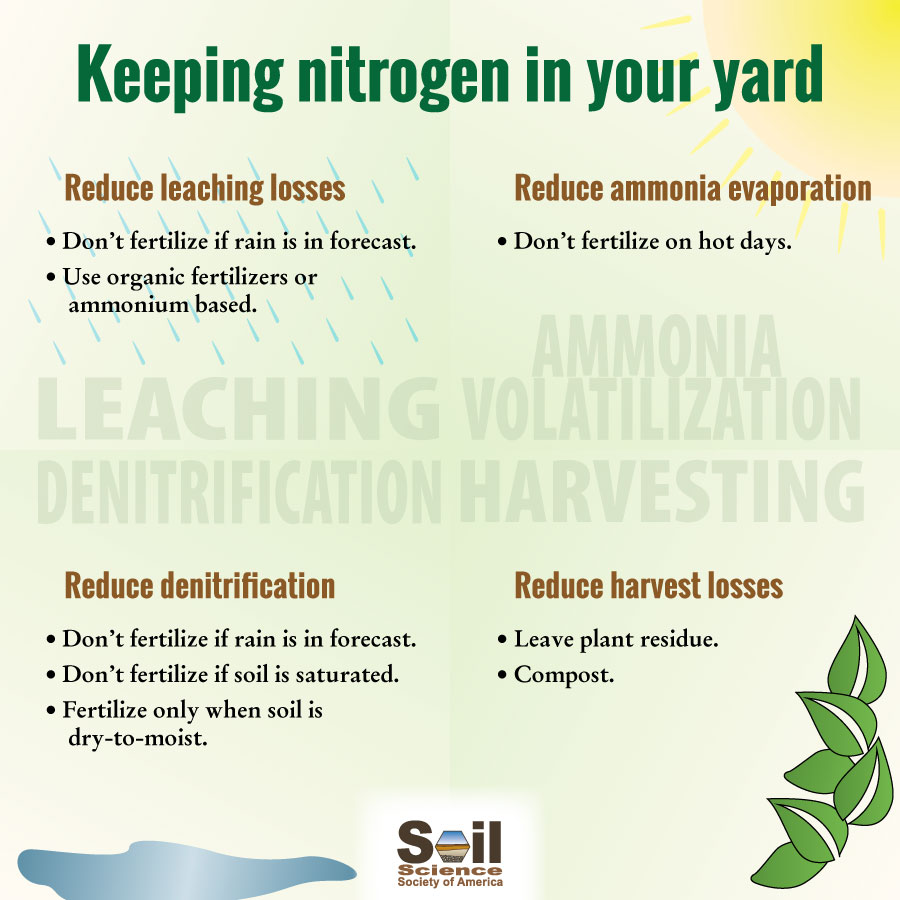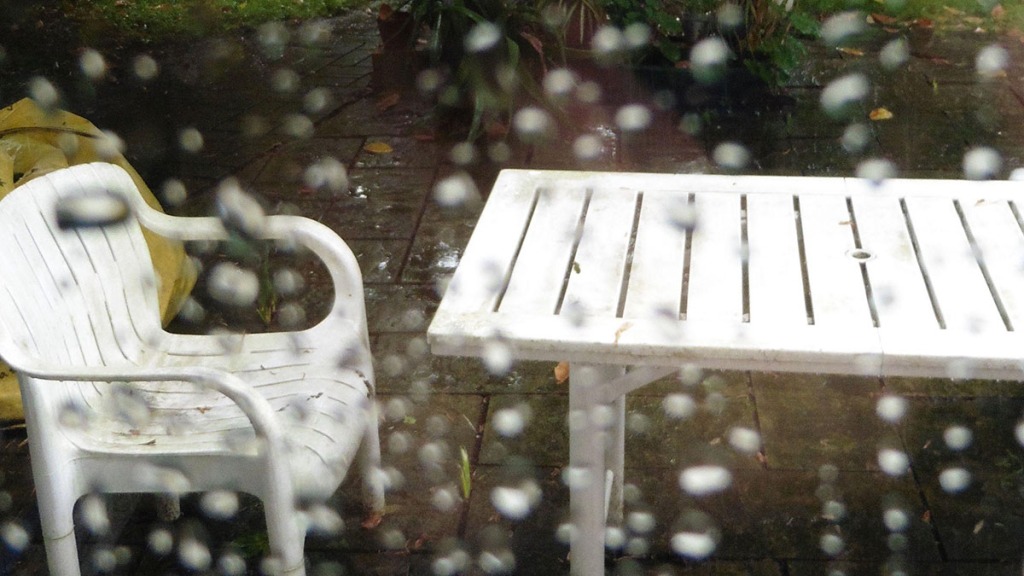If you garden, do lawn maintenance, or farm, you’ve probably added nitrogen fertilizer to your soil. Nitrogen is the most common nutrient to limit plant growth – because plants need quite a lot of it (10-60 g per kg of plant mass, to be exact). It also doesn’t stick around very long in the soil. Instead, it ends up in places where we don’t want it: in groundwater, water bodies, and even the atmosphere.
But, why? And how can we get nitrogen to stay in the soil, where plants need it?

To answer that question, we need to take a closer look at the nitrogen cycle. The nitrogen cycle, in which nitrogen moves through soil, water, air, and organisms, is one of the most complex element cycles. Luckily, keeping nitrogen in the soil simply involves reducing the losses of nitrogen from the soil. Losses are ways that nitrogen exits the soil.
To keep nitrogen in soil, we need to reduce 4 key losses:
- Leaching
- Ammonia volatilization
- Denitrification
- Harvesting
WHAT ARE LEACHING LOSSES?
Leaching happens when water travelling through the soil dissolves nutrients from the soil, and carries them downwards into the groundwater table. Leaching losses are largest in wet climates, especially regions with enough rainfall to support plant growth year-round. In the United States, for example, wetter regions east of the Mississippi River have much higher leaching losses than drier regions in the Southwest. In wetter areas, about 30% of nitrogen fertilizer is lost due to leaching. This leached nitrogen contributes to pollution in groundwater, lakes, rivers, and even the ocean.
How can I reduce leaching? Leaching losses are greatest following rainfall or irrigation. So, reducing them is mostly a matter of timing. If rain is in the forecast, wait until after it rains to apply nitrogen fertilizer (a little drizzle won’t matter, but watch out for steady rain or thunderstorms). If rain is a long way off, say a week or more, it is ok to apply fertilizer ahead of time. The type of fertilizer also matters. Nitrate doesn’t “stick” well to soil, and so it is lost very easily. To reduce leaching losses, avoid nitrate (NO3–) fertilizers, and instead choose ammonium (NH4+) or organic fertilizers (including urea, composts and manures).
WHAT ARE AMMONIA VOLATIZATION LOSSES?
Ammonia volatilization happens when ammonium (NH4+) loses a hydrogen (H+) and becomes ammonia (NH3). Ammonia is a gas, and so it can rapidly leave the soil to pollute the atmosphere. Ammonia volatilization is most likely to happen in alkaline soils (pH > 7) and when the soil is warm.
How can I reduce ammonia volatilization? Avoid applying ammonium fertilizers, composts, and manures on warm to hot days – especially if your soil is alkaline.
WHAT ARE DENITRIFICATION LOSSES?
Denitrification is a multi-step process where microbes convert nitrogen (in nitrate form, NO3–) into various nitrogen gases. One of these gases is nitrous oxide, N2O, a potent greenhouse gas. The other is nitrogen gas, N2, which is harmless and comprises 79% of the atmosphere. Denitrification happens when the soil gets very wet and stays wet for several hours to days. In very wet soil, microbes can’t get enough oxygen (O2). So, microbes “breathe in” nitrate instead of oxygen, and “breathe out” nitrogen gases (N2O and N2) instead of carbon dioxide (CO2).

How can I reduce denitrification? Similar to preventing leaching losses, avoid applying nitrate fertilizers before rainfall, and when the soil is very wet. Instead, use non-nitrate fertilizers, especially if the soil is saturated. When using any kind of nitrogen fertilizer, apply when the soil is dry to somewhat moist, and when the forecast is rain-free for the next few days. This will give the nitrogen time to be taken up by plants and “stick” to the soil before it rains. That way, denitrifying microbes growing in wet soil won’t have as much nitrate to “breathe in.”
WHAT ARE HARVEST LOSSES?
Harvest losses are exactly what they sound like – nitrogen that is lost when crops are harvested. Plants take up nitrogen from the soil, and when the plant is harvested and removed from the soil, the nitrogen is removed with it.
How can I reduce harvest losses? You can reduce harvest losses by only harvesting the part of the plant you need to eat, and turning the rest into mulch or compost. You can also collect the non-edible plant parts after harvesting, and return those to the soil. For example, instead of throwing green been stalks and trimmings in the trash, compost them first, and then add them to the soil.
ARE THERE OTHER WAYS TO KEEP NITROGEN IN SOIL?
Generally, increasing soil organic matter is a great way to improve nitrogen retention in the long term. Nitrogen “sticks” to organic matter, reducing both leaching and denitrification. Read this Soils Matter blog to learn how to keep more carbon – organic matter – in your yard.
Answered by Rivka Fidel, University of Arizona
To receive notices about future blogs, be sure to subscribe to Soils Matter by clicking on the Follow button on the upper right! Explore more on our webpage About Soils. There you will find more information about Soil Basics, Community Gardens, Green Infrastructure, Green Roofs, Soil Contaminants, materials for Teachers and more.

As a Certified Crop Advisor and 4R Nutrient Management Specialist, I think that rather than recommending only organic fertilizers, the recommendation should include slow release fertilizers (which includes organic), or even more broadly, Enhanced Efficiency Fertilizers. There are many advanced fertilizer technologies that conserve nutrients in the soil, resulting in increased plant uptake and reduced losses. In addition, the specific mention of urea as organic, while true, may not be the best BMP. Urea, while technically organic, is susceptible to rapid loss via volatilizations, leaching, runoff, and denitirfication.
Hi Eric – Thanks for reading. This is a blog for the general public. Are there enhanced efficiency fertilizers available broadly for them? svf
Organic composts are “natural” slow release site fertilizers. Just don’t add too much to your garden landscape at a time!
Hi everyone, though the information are for general public but I believe it can help out scientific community especially the multidisciplinary research professionals in making up their minds on this important area of research.
Best,
Zia